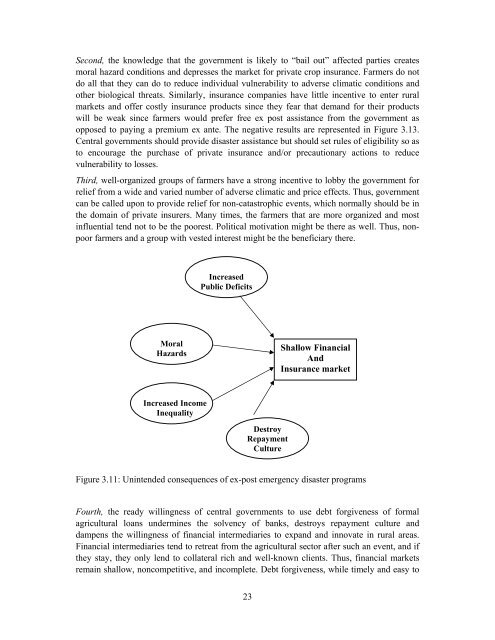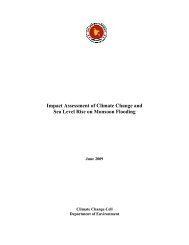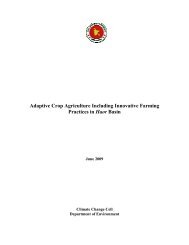Crop Insurance as a Risk Management Strategy in Bangladesh
Crop Insurance as a Risk Management Strategy in Bangladesh
Crop Insurance as a Risk Management Strategy in Bangladesh
Create successful ePaper yourself
Turn your PDF publications into a flip-book with our unique Google optimized e-Paper software.
Second, the knowledge that the government is likely to “bail out” affected parties creates<br />
moral hazard conditions and depresses the market for private crop <strong>in</strong>surance. Farmers do not<br />
do all that they can do to reduce <strong>in</strong>dividual vulnerability to adverse climatic conditions and<br />
other biological threats. Similarly, <strong>in</strong>surance companies have little <strong>in</strong>centive to enter rural<br />
markets and offer costly <strong>in</strong>surance products s<strong>in</strong>ce they fear that demand for their products<br />
will be weak s<strong>in</strong>ce farmers would prefer free ex post <strong>as</strong>sistance from the government <strong>as</strong><br />
opposed to pay<strong>in</strong>g a premium ex ante. The negative results are represented <strong>in</strong> Figure 3.13.<br />
Central governments should provide dis<strong>as</strong>ter <strong>as</strong>sistance but should set rules of eligibility so <strong>as</strong><br />
to encourage the purch<strong>as</strong>e of private <strong>in</strong>surance and/or precautionary actions to reduce<br />
vulnerability to losses.<br />
Third, well-organized groups of farmers have a strong <strong>in</strong>centive to lobby the government for<br />
relief from a wide and varied number of adverse climatic and price effects. Thus, government<br />
can be called upon to provide relief for non-cat<strong>as</strong>trophic events, which normally should be <strong>in</strong><br />
the doma<strong>in</strong> of private <strong>in</strong>surers. Many times, the farmers that are more organized and most<br />
<strong>in</strong>fluential tend not to be the poorest. Political motivation might be there <strong>as</strong> well. Thus, nonpoor<br />
farmers and a group with vested <strong>in</strong>terest might be the beneficiary there.<br />
Moral<br />
Hazards<br />
Incre<strong>as</strong>ed Income<br />
Inequality<br />
Incre<strong>as</strong>ed<br />
Public Deficits<br />
Destroy<br />
Repayment<br />
Culture<br />
Figure 3.11: Un<strong>in</strong>tended consequences of ex-post emergency dis<strong>as</strong>ter programs<br />
Fourth, the ready will<strong>in</strong>gness of central governments to use debt forgiveness of formal<br />
agricultural loans underm<strong>in</strong>es the solvency of banks, destroys repayment culture and<br />
dampens the will<strong>in</strong>gness of f<strong>in</strong>ancial <strong>in</strong>termediaries to expand and <strong>in</strong>novate <strong>in</strong> rural are<strong>as</strong>.<br />
F<strong>in</strong>ancial <strong>in</strong>termediaries tend to retreat from the agricultural sector after such an event, and if<br />
they stay, they only lend to collateral rich and well-known clients. Thus, f<strong>in</strong>ancial markets<br />
rema<strong>in</strong> shallow, noncompetitive, and <strong>in</strong>complete. Debt forgiveness, while timely and e<strong>as</strong>y to<br />
23<br />
Shallow F<strong>in</strong>ancial<br />
And<br />
<strong>Insurance</strong> market





